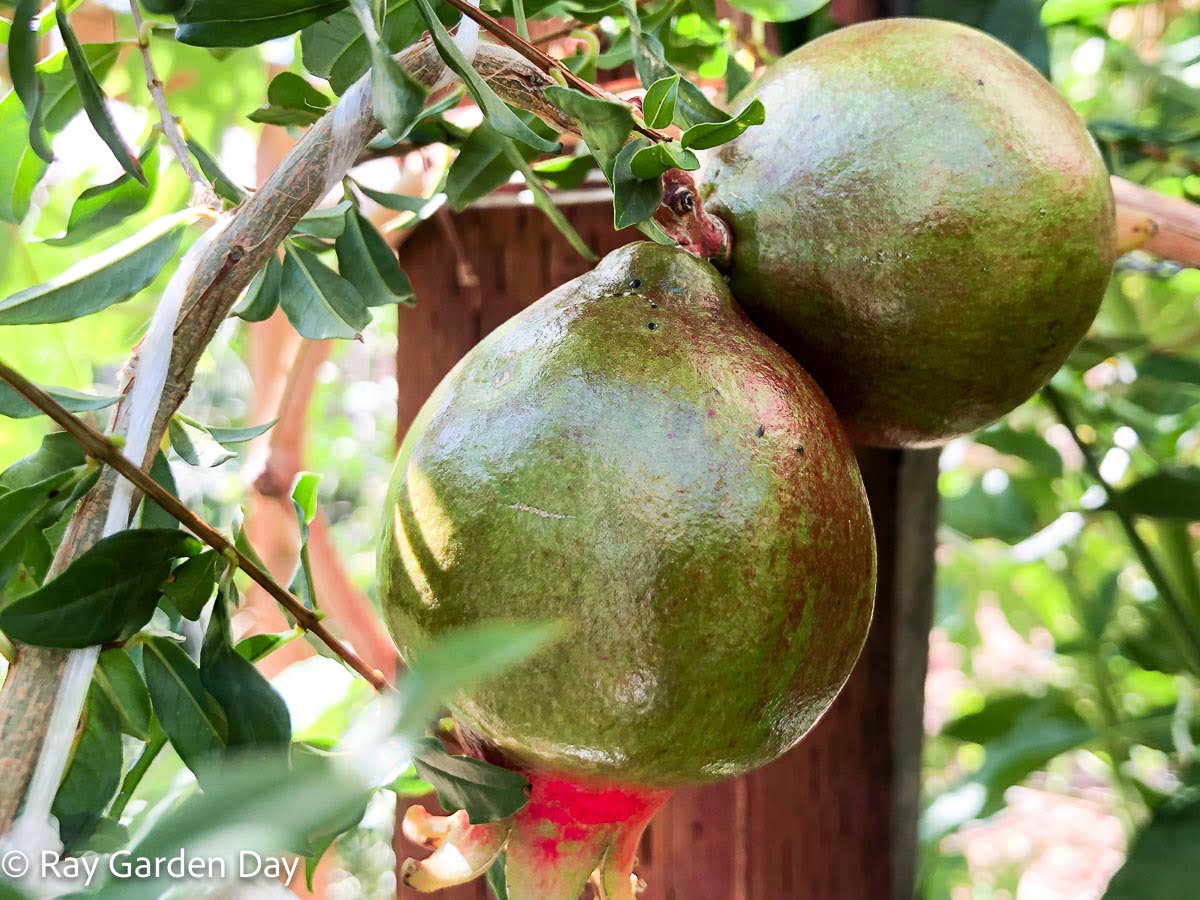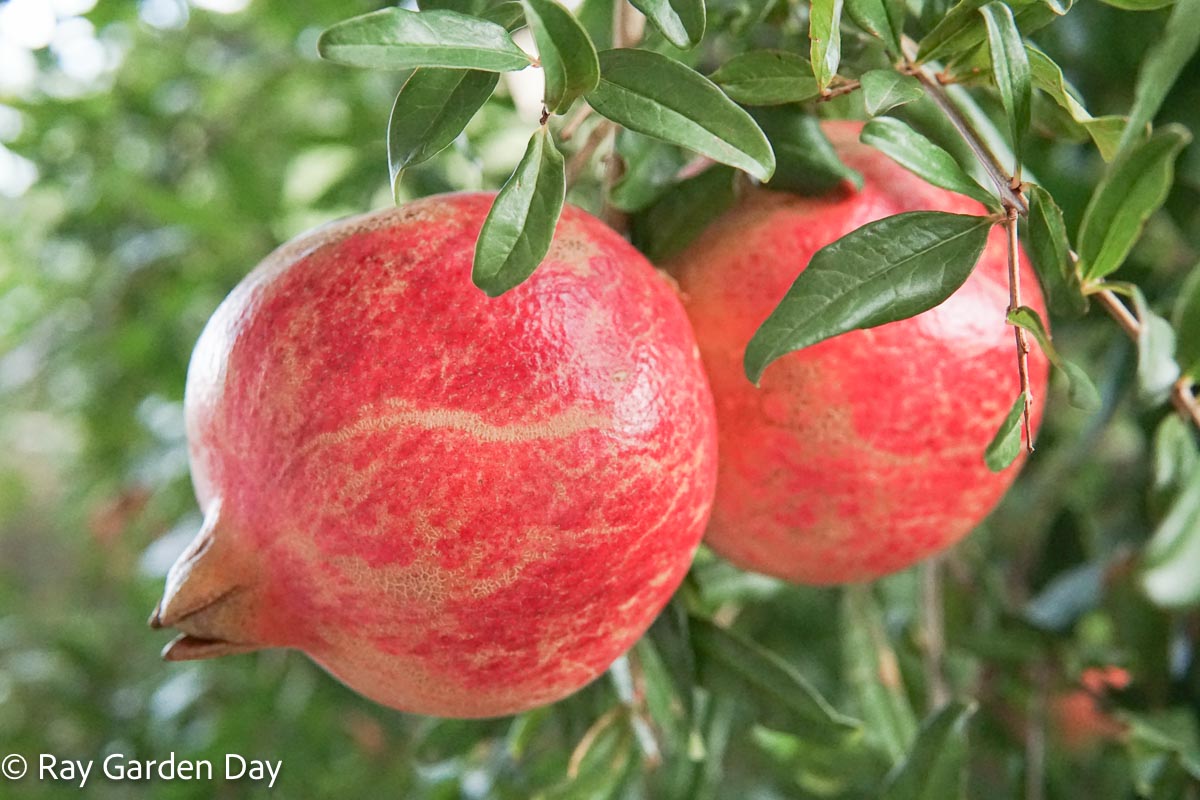Watching your pomegranates split on the tree long before they’re ready for harvest can be a frustrating experience.
Picture this: you’ve lovingly tended to your Wonderful and Parfianka pomegranate trees, eagerly awaiting that perfect moment of harvest, only to find prematurely split pomegranates on the branches.
The phenomenon of pomegranate splitting on the tree can be disheartening, and in the midst of the record-breaking hot summer of 2023, I encountered these challenges firsthand. The scorching heat can indeed be one of the contributing factors to this issue.

As a fellow pomegranate enthusiast, I share your excitement and frustrations when it comes to growing these vibrant fruits. But fear not, as in this comprehensive blog post, we’ll tackle the puzzle of pomegranate splitting and cracking together. We’ll explore the underlying causes, contributing factors, and effective solutions to ensure your pomegranates remain unscathed until they’re ready for consumption. Drawing from personal experiences and expert insights, I’ll guide you on a journey to nurture flawless pomegranates on your trees. Whether you’re an experienced grower or just starting out, let’s embark on this journey toward a bountiful, unblemished harvest.
Understanding the Causes of Pomegranate Splitting
Pomegranates can split or crack due to various factors, and understanding these reasons is the first step towards prevention. Here are some common causes:
- Overripe Pomegranates: Overly ripe pomegranates are more likely to split. Their skin becomes thinner and less resistant to pressure, making them vulnerable to cracking.
- Temperature Fluctuations: Rapid temperature changes can cause the fruit to expand and contract, leading to cracks in the skin. This can happen in regions with extreme heat.
- Moisture Levels: Excessive moisture can weaken the pomegranate’s skin, making it prone to splitting. This can happen if you store them in a humid environment or premature splitting in regions with heavy rainfall.
- Irregular Watering: Inconsistent watering during the growing phase can result in uneven fruit development, increasing the chances of splitting.
Preventive Measures
Now that we’ve identified the causes, let’s dive into how to prevent pomegranate splitting or cracking.
- Proper Irrigation: Maintain a consistent watering schedule for pomegranate trees, ensuring they receive adequate moisture during their growth. Avoid sudden overwatering, which can lead to fruit cracking.
- Proper Fertilization: Apply the appropriate fertilizers to promote healthy fruit development. Balanced nutrition can help strengthen the fruit’s skin.
- Pruning and Thinning: Prune pomegranate trees for good air circulation and sunlight exposure. Thinning the fruit clusters can help reduce competition for resources among fruits, preventing cracking due to overcrowding.
- Shade Structure for Temperature Control: To mitigate temperature fluctuations, especially in regions with extreme heat, consider installing a shade structure over your pomegranate tree. This provides protection from the scorching sun and rapid temperature changes, which can contribute to fruit splitting.
- Rain Protection and Drainage (for High-Rainfall Areas): In regions with heavy rainfall, use protective netting to shield pomegranates from moisture while allowing adequate air circulation. Additionally, ensure proper drainage around the tree’s base to prevent waterlogging, which can increase the risk of fruit splitting. Adequate drainage and protective netting work together to safeguard your pomegranate crop against the challenges of high rainfall.
- Pest and Disease Management: Regularly inspect your pomegranate trees for pests and diseases, as they can weaken the fruit’s skin. Address any issues promptly to maintain the fruit’s integrity.
- Harvesting at the Right Time: Harvest pomegranates when fully ripe but not overripe. Look for a rich color and firm skin, indicating optimal ripeness. Pomegranates harvested too early or too late are more likely to split.
- Store Properly: Store pomegranates in a cool, dry place with a consistent temperature. Avoid refrigerating them for extended periods, which can cause moisture buildup inside the fruit.
What to Do with Prematurely Cracked Pomegranates
Discovering prematurely cracked pomegranates on your tree can be disheartening, as these fruits have not ripened sufficiently for consumption. In such cases, salvage options are limited:
- Compost: The most eco-friendly option is to compost the prematurely cracked pomegranates. They will decompose naturally and contribute to the fertility of your garden soil.
- Discard: If composting is not an option, discard the prematurely cracked pomegranates. Unfortunately, these fruits are unsuitable for eating, juicing, or saving the seeds due to their underdeveloped state.
- Monitor and Adjust: To prevent future occurrences of premature cracking, closely monitor your pomegranate tree and continue implementing preventive measures discussed earlier in this article to ensure healthier fruit development.
While it may be disappointing to lose prematurely cracked pomegranates, proper care, and preventive measures can help minimize such occurrences and ensure a more bountiful and healthy harvest in the future.
Premature splitting of pomegranates on the tree can be a perplexing issue. Still, with the proper knowledge and practices, you can significantly reduce the likelihood of this occurrence. By addressing factors like watering, soil management, and varietal selection, you can ensure that your pomegranates remain intact until they’re ripe for consumption. Additionally, knowing what to do with prematurely cracked pomegranates allows you to maximize your harvest and minimize waste. With these preventative measures and handling tips, you can look forward to enjoying ripe and unblemished pomegranates in due time. Happy growing and harvesting!
Pomegranate Splitting FAQs
Why is my pomegranate splitting?
Pomegranates split due to irregular watering, sudden rainfall, fertile soil, varietal sensitivity, and heat stress. Preventive measures include consistent watering, mulching, pruning, rain protection, balanced fertilization, varietal selection, and timing of harvest. Protective netting and proper drainage help in high-rainfall areas, while shade structures mitigate temperature fluctuations.
Is it safe to eat pomegranates that have split open?
Yes, it is generally safe to eat pomegranates that have split open. However, check for spoilage and mold. The fruit is safe to consume if the seeds inside are undamaged and appear healthy. Otherwise, discard any spoiled portions.
How do you get rid of fruit cracking in pomegranates?
To eliminate fruit cracking in pomegranates, employ preventive strategies. Ensure consistent watering, mulch for moisture regulation, prune for air circulation, protect from rain, maintain balanced fertilization, select suitable varieties, time the harvest right, consider protective netting in heavy rainfall areas, and employ shade structures to mitigate heat fluctuations.
Why do my pomegranates split on the tree before they're ripe for harvest?
Pomegranates split prematurely on the tree due to irregular watering, sudden rainfall, varietal sensitivity, and heat stress. Maintaining consistent moisture, protecting from excessive rain, selecting suitable varieties, and mitigating temperature fluctuations can help prevent this issue.
What deficiency causes pomegranate fruit cracking?
Nutrient deficiencies can contribute to pomegranate splitting. An imbalance in nutrients like calcium and potassium can weaken fruit skins, making them more susceptible to cracking. Ensuring proper fertilization with a focus on balanced nutrition can help address this aspect of fruit splitting prevention.
Are certain pomegranate varieties more prone to splitting than others?
Certain pomegranate varieties are more prone to splitting than others due to variations in skin thickness and fruit structure. Smaller fruit varieties, such as ‘Crab,’ ‘Early Wonderful,’ and ‘Pink Satin,’ often exhibit reduced susceptibility to splitting compared to larger-fruited varieties, making them a preferred choice for growers looking to minimize this issue.
Is there a particular time during the growth cycle when pomegranates are most susceptible to splitting?
Yes, pomegranates are most susceptible to splitting during two distinct phases. Premature splitting occurs before they’re fully ripe and is often linked to irregular watering, sudden rainfall, and heat stress during the growing season. In contrast, fruit splitting due to not harvesting on time usually happens when the fruits remain on the tree for too long, becoming overripe and vulnerable to cracking.




